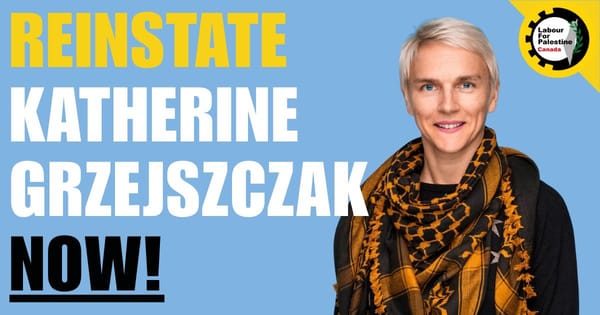
Hi Passengers,
My name is Adam King. I’m currently a Post-Doctoral Visitor in the Department of Politics at York University. Broadly, I research in the field of work and labour studies. My academic work deals with the political economy of work in the mining industry, as well as labour standards enforcement and employment policy.
My writing has appeared in Jacobin, The Conversation and the Winnipeg Free Press, as well as in academic journals such as Studies in Political Economy, Work, Employment and Society, Global Labour Journal, and Journal of Labor and Society. You might have also read an earlier article I wrote in Passage critiquing universal basic income and job guarantee proposals.
In this newsletter, I’ll be writing about work, unions, social policy and political economy. But really, my main objective is to bring you the hottest Marxist takes for you to spam your conservative dad’s inbox with.
I want to start this newsletter off by talking about the pandemic and what we should do to protect workers’ rights as businesses fully reopen.
Since the beginning of the COVID-19 pandemic the ability to shelter in place has been highly uneven. Class, race and gender have shaped transmission and risk of exposure as well as the capacity to remain ‘socially distanced.’ For those unable to work from home or take paid time off, remaining in paid employment — if it still existed — was the only option. Shelter-in-place orders would have been meaningless without the labour of these essential workers.
Consequently, workplaces were and remain significant sites of exposure to, and transmission of, the virus. So, as greater numbers of people return to work, we should be asking: What does a just reopening for workers look like?
If the lackluster vaccination plans of the federal and provincial governments thus far are any indication — as I’m sure they are — we’re likely looking at months or more before Canada is fully vaccinated. Even then, new variants and continued risk of spread through asymptomatic carriers mean work will remain dangerous for many.
Identifying the workplaces responsible for large numbers of COVID-19 cases but with few public health restrictions is a good place to begin. While high rates of infection and deaths in long-term care homes and other health care facilities have understandably received much public attention, large worksites like manufacturing and food processing facilities and warehouses and fulfillment centres have garnered less concern.
Often hidden from public sight, these workplaces have been lesser noticed yet significant sources of contagion. Workers in them — often precariously employed, without union protection or representation — have been sounding alarms about the lack of health and safety protocols and the inability to take adequate paid time off when potentially exposed to COVID-19, as well as the unrelenting productivity targets on the shopfloor.
For example, approximately 400 workers at Amazon fulfillment warehouses in Ontario’s Peel region tested positive for COVID-19 by last December, just as Premier Doug Ford’s government was implementing another shutdown. Amazon was, of course, exempt from the post-holiday provincial lockdown.
In general, governments have been reticent or entirely opposed to imposing shutdowns or even major health and safety controls on warehousing and logistics firms. While the Ontario Conservatives seemed most concerned with releasing confounding advisories about how many people could safely gather in your living room, they remained steadfast in their commitment to keep Amazon and other large private corporations free from public health restrictions.
This paucity of regulatory intervention indicates how vital warehousing and delivery services have been to allowing other people to work from home — and to keeping profits flowing to those who really matter.
In retail and other customer service oriented businesses, workers have also faced significant risks. Job loss due to government lockdowns hit low-wage workers particularly hard throughout the first wave of the pandemic. More recently, retail workers suffered the greatest number of lost jobs during the January shutdown. Those who have remained employed frequently dealt with understaffing issues, a lack of paid sick days and, all too often, demanding and abusive customers.
We need greater protections for these workers as well as those who are about to return to paid employment. Here are four things that should be done to protect workers’ rights and improve health and safety protections as we move toward full reopening across the country.
Legislate Paid Sick Days
As of August 2020, 58 per cent of workers in Canada had no access to paid sick days. Outside of Quebec and the federal jurisdiction, almost no Canadian provinces guarantee paid sick days through employment standards legislation (with the exception of Prince Edward Island, where you can take one paid sick day off after five years with the same employer). In 2017, then-Ontario Premier Kathleen Wynne’s Liberals introduced two paid sick days in the province, but Ford cut them when he was elected in 2018.
Canada (along with the United States) is a policy outlier when it comes to this issue. Most industrialized countries provide some type of paid sick leave at the first sign of illness. The current federal paid sick leave is complicated and imposes a waiting period before receiving benefits. It’s no substitute to accessible and immediate paid days off.
As the Decent Work and Health Network (DWHN) argues, paid short-term time off will be essential to stopping future waves of COVID-19. All 34 regional public health officials in Ontario have called on Ford to reinstate the paid sick days he cancelled. More ambitiously, the DWHN is calling on federal and provincial governments to introduce seven permanent paid sick days and an additional 14 days during public health emergencies. (You can send a letter to Prime Minister Justin Trudeau and your premier here).
Making low wage workers choose between health (their own and others’) and keeping a roof over their head is unconscionable, especially when many large corporations like Amazon and Loblaw have enjoyed huge profits during the pandemic. But it’s also just bad public health policy. Paid sick leave protects workers and the public, despite what Ford says.
Enforce Labour Standards
Employers violate basic labour standards routinely. On paper, most non-unionized workers have protections like the minimum wage, overtime, vacation and severance pay, and specified breaks during and between shifts. But ensuring bosses actually abide by these laws is another matter.
Studies show that low wage workers, particularly women, racialized workers and those without citizenship status, are more likely to have their employment rights violated. Moreover, the fear of employer retaliation frequently mitigates against workers filing complaints with Ministries of Labour.
New research in the U.S. also indicates that job losses due to COVID-19 made labour standards compliance worse. Essentially, rising unemployment due to the lockdowns was positively correlated with higher incidences of wage theft and other wage violations.
Given how unemployment increases the power of bosses, this shouldn’t be terribly surprising. The more unemployed workers there are around, the more emboldened employers feel to break the law and violate workers’ rights. We can’t let businesses, even those that are struggling, make up their losses on the backs of workers.
For workers without a union, enforcement through a provincial Ministry of Labour is the only option. Yet labour inspectorates are understaffed and underfunded. Along with cutting paid sick days, Ford cancelled the scheduled hiring of an additional 100 employment standards officers, whose job it is to investigate workers’ complaints and inspect workplaces.
We should be pressuring provincial governments to beef up Ministry of Labour staffing levels and dramatically increase the number of workplace inspections in order to ensure workers are not having their wages stolen or their rights violated. However, relying on governments — especially Conservative provincial governments — will be a losing strategy. Unions and other labour organizations also need to be involved in ensuring compliance with minimum labour standards.
The labour movement is indispensable to ensuring that all workers, whether or not they are currently union members, have the power to protect themselves from bosses.
Do Health And Safety Inspections
The ability to refuse unsafe work is an important part of labour law across Canada. However, the capacity to exercise this right — like all employment rights — depends on how much power workers have in their workplace. For non-unionized, low-wage and other workers in precarious situations, these rights are often out of reach. Moreover, as work refusals dramatically increased over the course of the pandemic, Ministries of Labour across the country upheld almost none of them.
As with ensuring minimum labour standards, it’s essential that workers and their advocates put pressure on provincial governments to ramp up health and safety inspections. There are some promising signs on this front. The Ontario government recently undertook an inspection blitz of large box-stores, beginning in the Greater Toronto Area and Hamilton, before moving to Ottawa, Windsor, Niagara, and Durham regions.
While this is a good start, inspecting retail is not enough. Manufacturing, warehousing and logistics firms must face the same scrutiny, given what we know about COVID-19 transmission and the often appalling conditions workers in parts of these sectors have recently faced. Additionally, fines for violations remain far too low. A $1,000 penalty for a COVID-related healthy and safety violation is not a meaningful deterrent for most large corporations.
Let’s draw on how popular ‘tax the rich’ sentiment is and advocate to ‘fine the rich’ when they violate workers’ rights to a safe and healthy workplace.
Make It Easier To Unionize
The above proposals, as necessary as they are, are nevertheless short term and insufficient. We ultimately need a much stronger labour movement in Canada, ready and willing to exercise its collective power and institutionally capable of bargaining for, and representing, greater numbers of workers.
Although Canadian union density has consistently held at around 30 per cent (even increasing slightly amidst the pandemic as job loss was concentrated among the non-unionized), efforts to grow the power of the labour movement are still desperately needed. This is particularly true in the private sector, where density remains just below 16 per cent.
The growth of precarious forms of employment have placed unionization increasingly out of reach for many workers. We need labour law reform to increase access to union representation and collective bargaining. Let’s harness the public appreciation for ‘essential’ workers to push for changes that could increase the power of workers and unions. Sectoral bargaining, universal card check certification in all provinces and outlawing employer use of ‘scabs’ across the country could form the planks in a new policy agenda for workers’ rights.
Over the past year, federal and provincial governments exposed workers, especially those in ‘essential’ industries, to undue risk. We need to make sure they can’t do that again.






